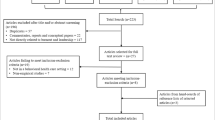Abstract
This study investigated whether aspects of burnout in clinical staff in community mental health agencies were systematically related to aspects of leadership behavior and quality of supervision of clinical supervisors. Burnout was measured by the Maslach Burnout Inventory, leadership behavior was measured by the Leadership Practices Inventory, and clinical supervision by a scale constructed by the authors. Significant, though moderate relationships were found between the measures, and the implications for an organizational model of burnout, as well as prevention of burnout in mental health professionals are discussed.
Similar content being viewed by others
REFERENCES
Beehr, T.A. (1985). The role of social support in coping with organizational stress. In T.A. Beehr & R.S. Bhagat (Eds.), Human stress and cognition in organizations. New York: Wiley.
Bush, J. (1977). The minority administrator: Implications for social work education. Journal of Education for Social Work, 13 15–22.
Cherniss, C. (1980). Professional burnout in human service organizations. New York: Praeger.
Cherniss, C. (1993). Role of professional self-efficacy in the etiology and amelioration of burnout. In W. Schaufeli, C. Maslach, & T. Marek (Eds.), Professional burnout: Recent developments in theory and research (pp. 135–149). Washington, DC: Taylor & Francis.
Cherniss, C. (1995). Beyond burnout. New York: Routledge.
Evered, R., & Selman, J. (1989). Coaching and the art of management. Organizational Dynamics, 18 16–31.
Freedman, A. (1997). Pathways and crossroads to corporate leadership. Paper presented in honor of Dr. Harry Levinson on the occasion of his 75th birthday at the 1997 annual convention of the American Psychological Association, Chicago, IL.
Glisson, C. (1989). The effect of leadership on workers in human service organizations. Administrative Leadership in the Social Sciences, 22 99–116.
Golembiewski, R.T., & Munzenrider, R. (1988). Phases in burnout: Developments in concepts and applications. New York: Praeger.
Guglielmi, R.S., & Tatrow, K. (1998). Occupational stress, burnout, and health in teachers: A methodological and theoretical analysis. Review of Educational Research, 68 61–69.
Kouzes, J., & Posner, B. (1993). Leadership practices inventory. San Francisco: Pfeiffer & Company.
Kouzes, J., & Posner, B. (1997). Leadership practices inventory. San Francisco: Pfeiffer & Company.
Leiter, M.P. (1991). The dream denied: Professional burnout and the constraints of service organizations. Canadian Psychology, 32 547–558.
Leiter, M.P. (1993). Burnout as a developmental process: Consideration of models. In W. B. Schaufeli, C. Maslach, & T. Marek (Eds.), Professional Burnout: Recent developments in theory and research (pp. 237–250). Washington, DC: Taylor & Francis.
Leiter, M.P., Gaudet, J., & Millett, M. (1986, June). Social support as a moderating variable in the relationship between job stress and professional commitment in nursing. Paper presented at the Annual Convention of the Canadian Psychological Association, Toronto.
Leiter, M.P., & Maslach, C. (1988). The impact of interpersonal environment on burnout and organizational commitment. Journal of Organizational Behavior, 9 297–308.
Leiter, M.P., Harvie, P., & Frizzell, C. (1997). The correspondence of nurse burnout and patient satisfaction. Poster session presented at the 1997 annual convention of the American Psychological Association, Chicago, IL.
Leiter, M.P., & Maslach, C. (1997). The truth about burnout. San Francisco: Jossey-Bass.
Maslach, C., & Jackson, S.E. (1986). Maslach burnout inventory manual (2nd ed). Palo Alto, CA: Consulting Psychologists Press.
Maslach, C., & Jackson, S.E, & Leiter, M.P. (1996). Maslach burnout inventory manual (3rd ed). Palo Alto, CA: Consulting Psychologists Press.
McNeely, R.L. (1992). Job satisfaction in the public social services: Perspectives on structure, situational factors, gender, and ethnicity. In Y. Hassenfeld (Ed.), Human services as complex organizations. Newbury Park, CA: Sage Publications.
Pines, A., & Kafry, D. (1978). Occupational tedium in the social services. Social Work, 23 499–507.
Pines, A., & Maslach, C. (1978). Characteristics of staff burnout in mental health settings. Hospital & Community Psychiatry, 29 233–237.
Author information
Authors and Affiliations
Rights and permissions
About this article
Cite this article
Webster, L., Hackett, R.K. Burnout and Leadership in Community Mental Health Systems. Adm Policy Ment Health 26, 387–399 (1999). https://doi.org/10.1023/A:1021382806009
Issue Date:
DOI: https://doi.org/10.1023/A:1021382806009




